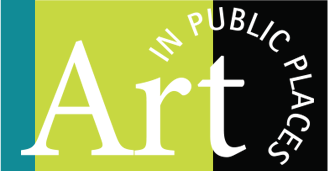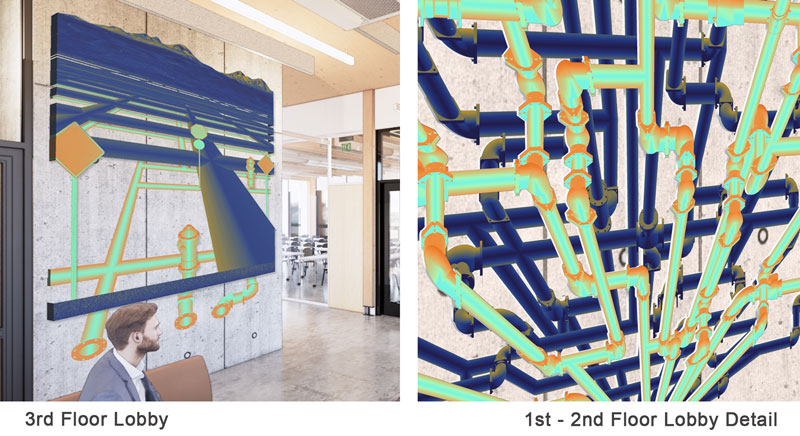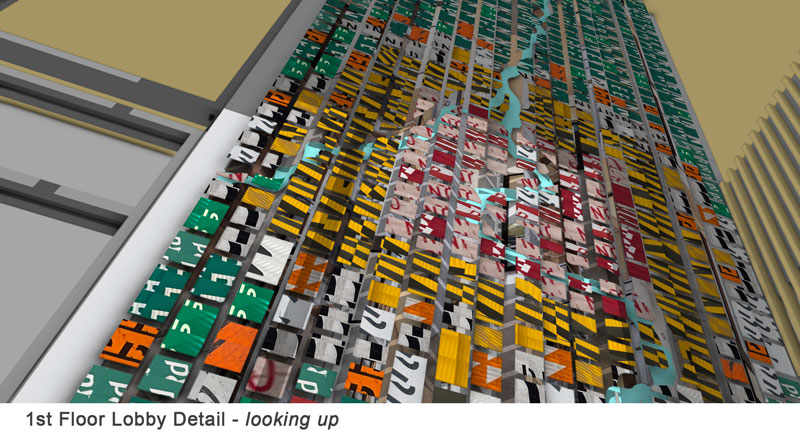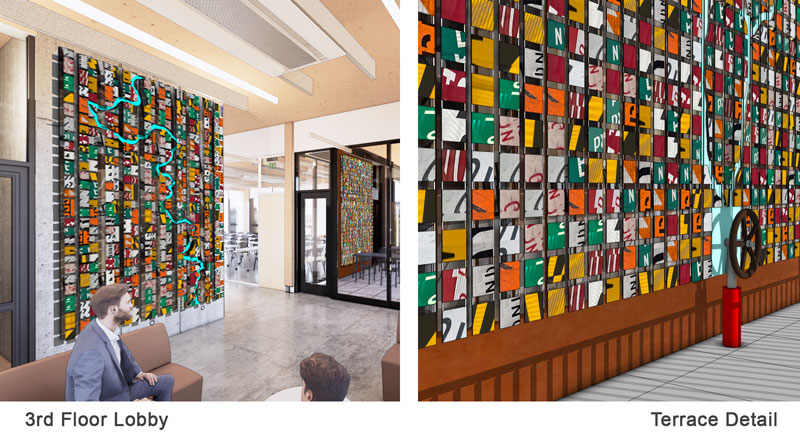Headquarters Lobby & Terrace
PUBLIC REVIEW AND INPUT
Design renderings of the proposed work of art for the lobbies and terrace in the Headquarters Building on the Public Works Campus will be on display at the downtown Bend Public Library and the Larkspur Community Center from June 15-25.
In 2007, City of Bend adopted a 1% for Art Program for city-owned construction projects to be dedicated to public art.
Community members of all ages are invited to review and provide input on the two finalist’s works of art mutually selected by representatives from the City of Bend, Bend City Council, Hennebery Eddy Architects and Art in Public Places.
Open the “Community Input” tab below. Submit your input plus any comments to our Selection Committee.
The two finalists are featured below. Open the various tabs within each section below to get more detailed information for each submission.
Find out more about Below the Surface
by FreelandBuck
Find out more about Water Tapestries
by John Fleming
Share your input below!
title: Below the Surface
by FreelandBuck
Our installation celebrates the unseen innovations that keep the city flowing, transforming the invisible into a luminous network that celebrates the unseen work of Bend Public Works.
- 1st Floor Lobby (8’ width x 26’-6” height)
- 3rd Floor Lobby (8’ width x 12’ height)
- Terrace (15’ width x 12’ height)
- View a detailed Poster
Notes & Inspiration (English)
Below the Surface
Printed Stainless Steel, LED Lighting
The design of the Public Works Headquarter building echoes the geologic character of the high desert, with a material palette that compliments the landscape. In contrast, our proposed artwork serves as a vibrant, bold core—a molten, crystalline interior that energizes the headquarters. It’s strategically positioned to be visible from the exterior drop-off area, inviting curiosity from the moment one arrives.
Our goal is to counter the invisibility of public works—so much of which is underground, hidden on the interior, or simply taken for granted. Visually and in subtle relief, the piece describes the immense infrastructural network the city relies on. During our tours of Public Works’ facilities, we were struck by the sheer volume of components made visible: pipes, rods, rings, fittings, gaskets, valves, nuts, bolts, wires, belts, bearings. Through its shape and assembly, each component suggests the performance of the larger system.
Our proposal attempts to make this vast, connected network visible. It’s not a precise diagram of how the system works, but rather a fantastical, impossible view of its scale and character. Rising up the two-story lobby wall to the third floor, it depicts a section cut through the city, exposing underground water and sewer systems, then moving above ground to the streetscape. From the ground floor, visitors will see an acute perspective from below, looking up toward the surface. In the third-floor lobby, this view is inverted, seen from above with the horizon in the distance. On the terrace, scaled-up details amplify the intricate pipe fittings, making them more visible from points around the building.
The piece is comprised of two layers, creating a depth that activates the image as one moves through the space. Constructed from laser-cut 16-gauge #6 stainless steel, the artwork is resilient. The steel is fully masked by a printed image that creates an applied materiality, vibrant yet allowing views through to the poured concrete wall behind. The porosity of the steel sheets complements the printed color palette. LED lighting embedded in the exterior portion illuminates the terrace, making the artwork a beacon visible from around the site.
In this way, our installation celebrates the unseen innovations that keep the city flowing, transforming the invisible into a luminous network that celebrates the unseen work of Bend Public Works.
Más información en Español
Bajo la Superficie
Edificio de la sede de Bend Public Works
(Obras Públicas de Bend) Acero inoxidable
estampado, iluminación LED
El diseño del edificio de la sede de Obras Públicas refleja las características geológicas del desierto, con una paleta de materiales que complementa el paisaje. En comparación, la obra de arte que proponemos actúa como un núcleo vibrante y audaz, un interior fundido y cristalino que le da energía a la sede. Se ha colocado estratégicamente para que sea visible desde la zona de entrega exterior y causa curiosidad desde el primer momento.
Nuestro objetivo es contrarrestar la invisibilidad de las obras públicas, muchas de las cuales son subterráneas, están ocultas en el interior o simplemente se dan por sentadas. De manera visual y en sutil relieve, la pieza describe la inmensa red de infraestructuras de la que depende la ciudad. Durante nuestras visitas a las instalaciones de Obras Públicas, nos llamó la atención el gran volumen de componentes hechos visibles: tuberías, varillas, anillos, conexiones, juntas, válvulas, tuercas, pernos, cables, correas, cojinetes. A través de su forma y ensamblaje, cada componente indica el rendimiento de un sistema más amplio.
Nuestra propuesta intenta hacer visible esta vasta red interconectada. No es un diagrama preciso de cómo funciona el sistema, sino más bien una visión fantástica e imposible de su tamaño y características. Subiendo por la pared de dos pisos del vestíbulo hasta el tercer piso, representa una sección abierta a través de la ciudad, dejando al descubierto los sistemas subterráneos de agua y alcantarillado, para pasar después a la superficie y al paisaje urbano. Desde la planta baja, los visitantes verán una perspectiva profunda desde abajo, mirando hacia la superficie. En el vestíbulo del tercer piso, esta vista se invierte, vista desde arriba con el horizonte a lo lejos. En la terraza, los detalles ampliados aumentan las complejas conexiones de las tuberías, haciéndolas más visibles desde distintos puntos alrededor del edificio.
La pieza se compone de dos capas, creando una profundidad que activa la imagen a medida que uno se desplaza por el espacio. Fabricada en acero inoxidable N.º 6 cortado con láser, la obra es resistente. El acero está totalmente oculto por una imagen impresa que crea una materialidad aplicada, vibrante, pero que permite ver el muro de concreto que está detrás. La porosidad de las planchas de acero complementa la paleta de colores impresa. La iluminación LED incrustada en la parte exterior ilumina la terraza, convierte la obra de arte en un faro visible desde toda la sede.
De este modo, nuestra instalación celebra las novedades invisibles que mantienen el flujo de la ciudad, que transforman lo invisible en una red luminosa que celebra el trabajo oculto de las obras públicas de Bend.
Community Input
If you’d like to see this entry chosen for the Lobby & Terrace of the new Public Works Campus, please provide your Public Input here!

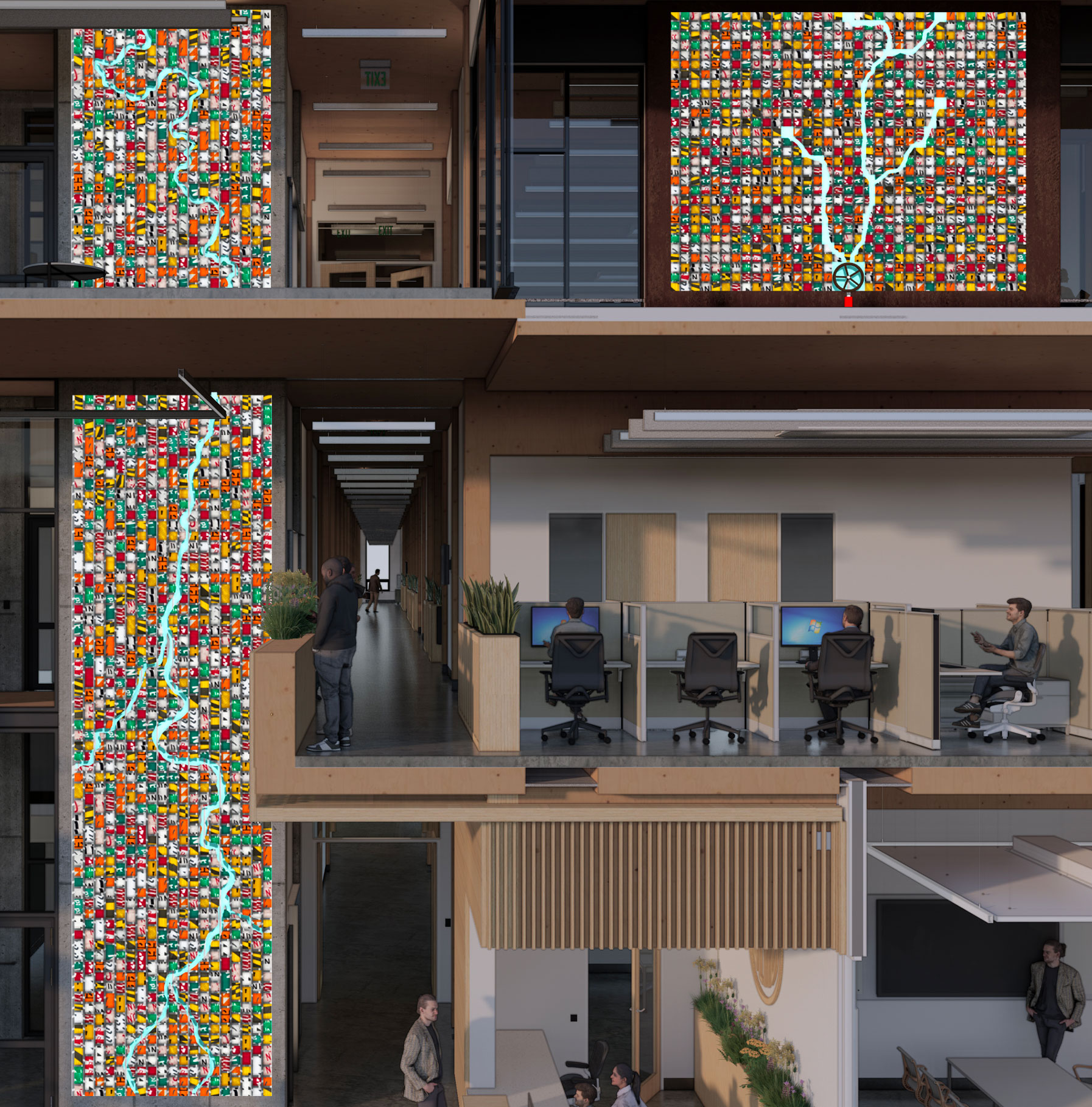
title: Water Tapestries
by John Fleming
The work of art suspended in the first and third-floor lobbies illustrating the course of the Deschutes River as it flows from Benham Falls, through Bend, and down toward the new Public Works Campus.
-
- 1st Floor Lobby (7’-10” width x 27’-10” height)
- 3rd Floor Lobby (7’-10” width x 12’-8” height)
- Terrace (14’-6” width x 12’-0” height)
- View detailed Poster
Notes & Inspiration (English)
Water Tapestries
Repurposed traffic signs (aluminum with prismatic film) attached to mirror-finish stainless steel reflectors
Bend gets its name from the bend in the Deschutes River where early inhabitants established a fordable crossing. Over the years the river was dammed to provide energy and create a way to float logs to the mills. Canals were dug to distribute the water to farmlands and wells were drilled into the aquifer. Most of Bend’s drinking water comes from springs in the Bridge Creek watershed.
To say the least, water plays an important role in Bend. I’ve been inspired by this water system and the maps that help to illustrate it. What if these maps were woven into a tapestry for Bend’s Public Works Headquarters?
I propose just that. In the first- and third-floor lobbies I’d suspend a 42-foot-tall tapestry (in two sections) illustrating the course of the Deschutes River as it flows from Benham Falls, through Bend, and down toward the future Public Works Campus. For the Terrace, I’d suspend another tapestry showing the watershed that feeds the Bridge Creek Pipeline.
Many of my past art projects make use of salvaged and repurposed materials. I was delighted to learn that the architects and staff at the Public Works Department shared this belief in the three Rs: Reduce, Reuse, Recycle. During our facilities site tour I saw a vast array of materials that might be available for inclusion in the artwork.
I propose fabricating my Water Tapestries from the city’s castoff aluminum traffic signs. Their colors and graphics create a rich mosaic and their prismatic film surfaces provide a surprising glow for nighttime illumination. Suspended behind these strands of sign fragments I propose a curtain of mirror-finish stainless steel plates. These mirrors will add a mysterious depth to the artwork. The slight movement of air in the lobby will create a gentle shimmering, the illusion of water flowing under the surface.
Más información en Español
Tapices de Agua
Señales de tráfico reutilizadas (aluminio con lámina prismática) fijadas a reflectores de acero inoxidable con acabado espejo
Bend debe su nombre a la curva (bend) del río Deschutes, donde los primeros habitantes establecieron un cruce navegable. A lo largo de los años, el río fue represado para suministrar energía y crear una vía para hacer flotar troncos hacia los molinos. Se excavaron canales para distribuir agua a las tierras de cultivo y se perforaron pozos en el acuífero. La mayor parte del agua potable de Bend procede de manantiales de la cuenca de Bridge Creek.
Sin duda, el agua desempeña un papel importante en Bend. Me he inspirado en este sistema de agua y en los mapas que ayudan a ilustrarlo. ¿Y si estos mapas se tejieran en un tapiz para la sede de Obras Públicas de Bend?
Esa es mi propuesta.. En los vestíbulos del primer y tercer piso colgaría un tapiz de 42 pies (unos 12 metros) de alto (en dos secciones), que ilustraría el curso del río Deschutes desde las cataratas Benham, pasando por Bend, hasta la futura sede de Obras Públicas. Para la Terraza, colgaría otro tapiz que mostrara la cuenca que alimenta la tubería de Bridge Creek.
Muchos de mis proyectos artísticos anteriores utilizan materiales reciclados y reutilizados. Me alegró enterarme de que los arquitectos y el personal del Departamento de Obras Públicas comparten la creencia en las tres erres: Reducir, Reutilizar y Reciclar. Durante nuestra visita a las instalaciones vi una gran variedad de materiales que podrían incluirse en la obra de arte.
Propongo fabricar mis Water Tapestries (Tapices de Agua) con las señales de tráfico de aluminio desechadas por la ciudad. Sus colores y gráficos crean un interesante mosaico y sus superficies de lámina prismática proporcionan un brillo sorprendente para la iluminación nocturna. Colgando detrás de estos fragmentos de señales, propongo una cortina de placas de acero inoxidable con acabado espejo. Estos espejos le añadirán una misteriosa profundidad a la obra de arte. El ligero movimiento del aire en el vestíbulo creará un suave centelleo, la ilusión de que el agua fluye bajo la superficie.
Community Input
If you’d like to see this entry chosen for the Lobby & Terrace of the new Public Works Campus, please provide your Public Input here!
